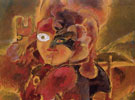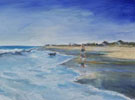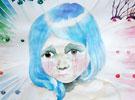Light on our future steps
Interview with Zhang Xiaotao
Cecilia Freschini
Cecilia Freschini: The Sakya project is a very complex task you have choose to keep on... Both for technological and human skills... Probably the heaviest one you had dealt with recently... Right?
Zhang Xiaotao: The Sakya project is a fusion of Tibetology, Tibetan Buddhism, archaeology, digital technology and new media language. The project comprises two parts, a documentary and an animated film. Since its inception in 2007 to its production in 2010, it has been quite difficult both financially and technically, but I was quite happy to take on the complex challenge of a “virtual art project.” For me, it’s like a breakthrough. The preparatory period was very long and involved a massive amount of time and effort. I wanted to discard with the conceptualized production model of contemporary art. Completion of these two films was sure to be a long process; it is the fusion of technology and concept, and touches on new fields of study. It required a slow process of practice and learning, but I believe that “true knowledge only comes through great difficulty”.
Freschini: Sure. I completely understand that in terms of time, budgets, technical equipment and staffs it has costs a lot, but also concerning your person, I believe that physically and psychologically it has costs a lot to your self... What brings you and helps you to deal with this till the end?
Zhang: I never count the costs of the project. Whether it’s in terms of time, effort or money, I don’t mind spending it. Passion is the greatest teacher, the greatest motivator. The production of an experimental animation and a documentary are team efforts that require systemic management and practices. Contemporary art is the production of knowledge, and the artist is the producer of images. I’m more concerned with the knowledge system behind the image. Artworks are the encoding and transcendence of the scene, history and the soul, and art is the torch we use to illuminate the long dark night that is the future. I hope to always have this warm power in the heart.
Freschini: Yes, nowadays the mystic factor is underestimated, but I do agree that is an essential part of ourselves that we have to learn to face with. Especially in art field, the transcendental is in fact very related with the substance of the artwork. You had a really strong intention and this project, obviously means a lot to you not just as an artist but for sure also as a person... Can you describe how this project born up and which feeling drive you into it?
Zhang: This determination is possibly rooted in the traditional education I received as a child. Learning things like calligraphy and martial arts require a long, slow process of practice and learning. Skills must be cultivated. There is an ancient Chinese parable about how a drop of water can penetrate stone. I think that drops can accumulate to the point that they can change the future. Perseverance is very important. Since I was a child, I was always taught that “perseverance is victory.” The Sakya project is a “virtual art project” that went through several key stages: 1, in 2007 I went to Tibet for a month to investigate the Sakya Monastery, and I shot a large amount of footage; 2, in 2008 I started developing the concept for Sakya, collecting materials, writing the script and systematically reading up on Tibetology, Archaeology and Buddhism; 3, in 2010 I brought a team to Tibet to film the Sakya documentary and brought a team together to begin production of the Sakya animated film. I completed the Sakya documentary and animated film between 2010 and August 2011.
My decision to do this project was connected to the Buddhist influence in my life since I was a child. Childhood influence is a seed, and when you grow up, it will surely flower and produce fruit. I was deeply moved when I went to the Dunhuang Grottoes for the first time in 1993, to the point that I lacked the language to express it. Art created under the power of great belief and spirit is timeless. I’ve always been obsessed with ancient Chinese artistic stone carving, portrait tablets, woodcarving, ceramics and the like. I’ve always been very curious about this thread. Artists should have a place in their hearts for religion. Art is the artist’s personal religion, and the job of the artist is to follow the path of transcendence. Buddhism began its spread into China during the Han dynasty, and brought massive changes to Chinese history and the progression of culture and society. I’m very curious about the history of Tibetan Buddhism, with its fusion of religion and politics during the Yuan dynasty. I want to know about the situation of Tibetan Buddhism today. I want to unlock those secrets from within Sakya Monastery. It’s all rooted in curiosity.
Freschini: What was your first intention when you start and which considerations when you end it up with this project?
Zhang: My original idea was to fuse animation and documentary film. I’m interested in the intersection of experimental animation and cinematic language. Now I’ve nearly completed this project, and I have quite a few regrets; it was difficult to fuse the team and the technique, it was difficult to fuse the languages of animation and cinema, and so in the end I decided to split the two films apart. The animated film is about the virtual world and the documentary is a real world. Five virtual people pass through the same tunnel through time and space, entering into a multidimensional, game like world. The film is in the editing and postproduction process now, as is the sound. I hope for Sakya to transcend Mist, my previous animated film. I want for it to make breakthroughs in terms of language, technique, aesthetics and conceptual expression. Experimental animation is very technical, and it is difficult to make any breakthroughs. Experimental animation is also full of regret. I want to find a new path through trial and error. Every time I finish a project I gain a lot of knowledge and experience. This will be valuable as a reference for the future.
Freschini: In these three years, thinking and discussion on the history and secularization of Tibetan Buddhism have been evolved... you decided to use Sakya as a model for your project… why? Can you introduce a little Sakya Monastery , his importance and his historical role in the Tibetan Buddhism culture?
Zhang: The Sakya sect was established in the 11th century by Khon Konchog Gyalpo in the 11th century, and spread by his grandson, Kunga Nyingpo. There were five leaders of the Sakya sect beginning with Kunga Nyingpo, and they became known as the “Five Venerable Supreme Masters.” Outside of Kunga Nyingpo, the most famous masters were the fourth one, Sakya Pandita, and the fifth one, Chogyal Pakpa (born Drogon Chogyal, responsible for converting Kublai Khan to Buddhism and named the Priest-King of Tibet under the Mongols). With the support of the Yuan dynasty government, the Sakya sect came to rule all of Tibet, setting the precedent of theocratic rule in Tibet. The head of the sect was often not a monk but a hereditary ruler. In the later history of the sect, one of the most famous masters was Rendawa Shyonnu Lodro, who was the most important teacher of Je Tsongkhapa, the founder of the Gelugpa (Yellow Hat) sect. Tsongkhapa’s famous Migtsema Prayer was originally composed as a prayer to Rendawa. When Yuan rule spread into the Central Plains of China in the 13th century, the Sakya sect gained immense political power. The fourth Sakya leader Pandita and the fifth Sakya leader Pakpa both made great contributions to the solidification of Yuan rule. Pakpa was named the Imperial Preceptor by Kublai Khan, and he invented the “Pakpa Script.” This new Mongolian script was used throughout Mongolia and played a large role in the progress of Mongolian society and culture.
The Sakya Monastery is not only the founding temple of the Sakya sect; it is also highly revered by all sect members and across Tibetan society. It has a rich cultural atmosphere and is famous throughout the world. It served as the seat of a theocratic regime that ruled Tibet for a time. The temple has over 900 years of history, including roughly 70 years as the seat of Tibetan political power. The complex is home to a rich collection of Tibetan texts and cultural relics, most famously religious sutras. The Sakya texts are collected in three places, the Utse hall of the north temple, the library of the Gurong hall and the main hall of the southern temple, with a combined total of roughly 24,000 texts. The Utse hall was the earliest library at Sakya, and was said to be already full of books before the time of Pakpa, who also brought in a few precious texts. Aside from the large number of handwritten Tibetan texts, the hall also contains many Sanskrit palm leaf sutras and Chinese scroll sutras. All of these texts are exquisitely handwritten in gold, silver, cinnabar or ink. For this reason, some scholars believe that the scripts and frescoes of the temple are comparable in beauty to the Mogao grottoes at Dunhuang, and call it the “second Dunhuang.” Aside from these three main libraries, there are many handwritten manuscripts to be found in the smaller shrines and the two remaining palaces.
Sakya County covers 7510 square kilometers and has a population of 45,019. The Sakya Monastery is a holy place for the Sakya sect. The north temple was destroyed in the Cultural Revolution, and the south temple has been renovated many times. The monastery hosts many religious gatherings of various sizes every year, the largest being the Vajra Dances held in summer and winter. The summer Vajra dance is held each year in the seventh month of the Tibetan calendar and the winter dance is held on the 29th day of the eleventh month. When the dance is performed, the dancers wear masks of the Sakya Dharmpala (protector spirits) and various beasts. The dances use simple narratives to visually reflect the basic processes of esoteric exorcism. During these two major gatherings, thousands of monks and common people gather in Sakya from far and wide to pray for peace and prosperity.




